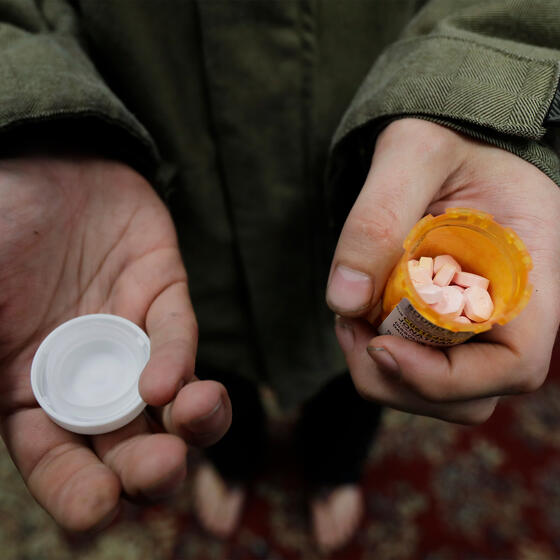Buprenorphine Can Transform Treatment of Opioid Addiction, But It Isn’t Reaching Enough Patients
The drug buprenorphine is a safer and more effective treatment for opioid use disorder than its predecessors. But according to a new study co-authored by Yale SOM’s Marissa King, most patients aren’t staying on the drug long enough to get its benefit, and it isn’t reaching young people.

A patient with a bottle of buprenorphine outside a clinic in Olympia, Washington, in November 2019. AP Photo/Ted S. Warren.
By Susie Allen
When buprenorphine was introduced as a treatment for opioid use disorders in 2003, it was viewed as a game changer. Its overdose risk was lower than the alternative therapy, methadone, and its side effects less overwhelming. Patients who switched to buprenorphine after years on methadone felt new hope they might someday live medication-free. As one doctor put it, “My hope and my expectation is that buprenorphine will revolutionize heroin treatment in the United States.”
Seventeen years later, with the U.S. still in the throes of the opioid epidemic, is buprenorphine fulfilling its promise and reaching the patients who need it? Yes and no, according to a recent study in Health Affairs co-authored by Marissa King, professor of organizational behavior at the Yale School of Management.
King and her co-authors found that buprenorphine access has indeed expanded: treatment rates increased dramatically from 2010 to 2018, a trend driven in large part by primary care providers. However, this growth hasn’t reached one key population: young patients ages 15–24. In contrast to other age groups, their buprenorphine treatment rates declined.
Moreover, for patients of all ages, sustaining treatment remains a significant challenge: the vast majority aren’t staying on buprenorphine for the 180-day regimen shown to be most effective.
“Over the past decade, there has been a radical expansion in access to treatment,” said King. “But, critically, there are still pretty significant gaps. And it still appears that patients who are getting treated are undertreated.”
Read the study: “Buprenorphine Treatment by Primary Care Providers, Psychiatrists, Addiction Specialists, and Others”
To understand trends in buprenorphine use, King and her co-authors used IQVIA Real World Longitudinal Prescription Data, a database that records prescription information for people across the United States. This tool allowed the researchers to see which patients were getting buprenorphine, how long they stayed on the medication, and who prescribed it for them—a primary care physician, a psychiatrist or addiction specialist, or (more rarely) another type of provider, such as a medical specialist, dentist, or pharmacist.
Understanding the source of buprenorphine prescriptions is a good indicator of access, King explains. Addiction specialists and psychiatrists were once the gatekeepers of medication-assisted treatment but can no longer keep up with demand, so there’s been a movement to allow primary care providers to prescribe therapies such as buprenorphine.
“Being able to understand whether primary care doctors are prescribing buprenorphine and whether that’s a viable path towards expanded access is important,” King says.
On that front, there was good news. Overall, the buprenorphine treatment rate per 10,000 people increased from 23.6 in 2010 to 44.3 in 2018. Treatment initiated by primary care providers accounted for much of that growth: the rate of buprenorphine treatment initiated by primary providers increased from 12.9 to 27.4 per 10,000 people over that eight-year span. (Treatment initiated by psychiatrists, addiction specialists, and other providers increased too, though more modestly.)
Next, the researchers examined buprenorphine treatment rates by patient age. Most age groups saw significant increases, with patients ages 35–44 seeing the most notable jump. Once again, primary care providers drove the trend: among adults ages 35–44, the rate of buprenorphine prescribed by primary care providers increased more than 15% from 2010 to 2018.
But one group not benefiting from increased buprenorphine access was people ages 15–24. In fact, they were the only patients for whom buprenorphine treatment rates declined, from 20.4 to 14 per 10,000 population from 2010 to 2018.
King doesn’t know for sure why young people aren’t receiving buprenorphine: perhaps they are less likely to seek treatment because they are early in their addiction cycle. They may also face structural obstacles when seeking help, including gaps in health care coverage, pediatricians reluctant to prescribe buprenorphine, and a lack of treatment centers willing to accept minors.
“All three of those pieces”—seeking help, finding someone willing to provide it, and being able to pay for it—“have to come together for someone to be treated effectively and to sustain treatment,” King says.
The issue of sustaining treatment was one King and her co-authors examined closely. “What we care about is not just who’s initiating treatment or who’s getting medication for the first time, but who is staying on the medication for long enough for the risk of relapse and overdose to decrease,” she says.
Studies show that buprenorphine is most effective when it’s used for at least 180 days. But the researchers found that for all too many patients, this essential milestone is not being met.
Although they did see a statistically significant increase in the percentage treatment episodes reaching the 180-day benchmark—up to 29.3% in 2017 from 23.7% in 2010—those numbers are still worryingly low. And young people, again, experienced the worst outcomes. From 2010 to 2017, the percentage of patients ages 15–24 receiving buprenorphine for at least 180 days dipped from 20.5 to 19.3.
This problem of undertreatment, King notes, is one of the “most pressing needs” the research revealed.
Taken together, what does all of this mean for the course of the opioid epidemic?
“While it’s great that we’re starting to see declines in overdose and mortality rates, there’s still a huge unmet burden for treatment,” King says. To solve that problem, policymakers and the healthcare system need to reduce barriers—including lingering stigma against the use of therapies such as buprenorphine. “It’s critical that people talk more openly about the need for medication-assisted treatment.”